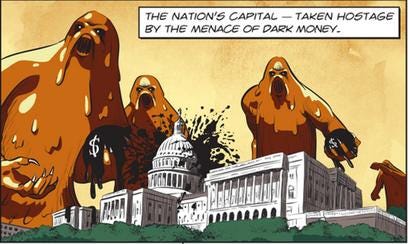Ch 1.10 | 💰Citizen's United = dark money
In the 2010 Supreme Court case Citizens United v. Federal Election Commission, a conservative nonprofit group called challenged campaign finance rules after the FEC stopped it from promoting and airing a film criticizing presidential candidate Hillary Clinton too close to the presidential primaries. A 5–4 majority of the court sided with Citizens United, ruling that corporations and other outside groups can spend unlimited money on elections.
In writing the opinion for the majority, Justice Anthony Kennedy declared the sale of access to elected officials is not corruption and that
“the appearance of influence or access, furthermore, will not cause the electorate to lose faith in our democracy.”
Relying upon Citizens United, courts and the FEC have issued decisions that led to the creation of “super PACs,” political committees that spend money to promote or oppose candidates for office, but must operate independent of candidates. They can take unlimited donations from individuals, corporations, and labor unions. And the super PACS are not required to disclose the source of the money funding their political efforts (unlike candidates’ campaign committees and political action committees), giving rise to the term “dark money.”
The legal rationale flowed directly from Citizens United: If independent spending cannot corrupt, then contributions to fund independent spending cannot corrupt either.
The impact of the Supreme Court’s opinion in Citizens United was profound.
In 2014, only four years after the Supreme Court’s decision in Citizens United, 0.001% of the population donated 29% of all political contributions. In the 2020 presidential election cycle, the "political industrial complex" spent an estimated $14.4 billion dollars. Of that, 80% came from large donors, and more than $1 billion came in the form of dark money. Because of substantial underreporting, actual direct political spending is many billions of dollars higher. Just factoring in estimates of so-called shadow lobbying, for example, would easily increase that to in excess of $20 billion.
This single Supreme Court decision served to ensure that political influence was tilted towards wealthy donors and corporations.
As Katherine Gehl and Michael Porter explain in their book:
Roughly 40 percent of this total was election spending by candidates, parties, PACs, super PACs, and other organizations; another 40 percent was reported for lobbying of Congress and government agencies by companies, trade associations, unions, and other special interest groups. … It came from the pharmaceutical lobby, the insurance lobby, the gun lobby, small business lobbies, and unions. The National Rifle Association, for example, spent $412 million on political activities in 2016, in addition to guiding its 5.5 million members on how to vote. The health-care sector funneled $268 million to influence elections and spent $1.02 billion on lobbying. Keep in mind that these numbers only pertain to the federal level of the politics industry. If we were to add spending at the state level, these estimates would balloon.
While these figures are staggering, they severely underestimate the total size of the industry. Politics is also big business for the media. At least $1.5 billion was spent on advertising during political shows on channels such as CNN, Fox News, and MSNBC. The remaining balance flows to the budgets of major think tanks like the Center for American Progress or the Heritage Foundation. Together, the industry is responsible for at least nineteen thousand jobs and thousands more in consulting.
This estimate excludes politically active nonprofits and social welfare organizations, such as the National Rifle Association, the Sierra Club, the American Civil Liberties Union, and Americans for Prosperity, all of which work tirelessly to influence public policy. If we include the revenue of all these political organizations, the politics industry inflates to over $100 billion dollars per election cycle.
Most importantly, the politics industry determines how the government spends an almost unimaginable amount of money—$ 3.9 trillion in fiscal year 2016 at the federal level alone.
If you are interested in diving in deeper here, there is an amazing organization called American Promise that is advancing a constitutional amendment to reverse Citizens United. American Promise says they are a “cross-partisan organization committed to a singular vision: ratifying the For Our Freedom Amendment to empower the states and Congress to set reasonable limits on political spending, ensuring every American voice counts”.
But it’s not just the influence of money that is driving such perverse outcomes. Two other issues plague our ability to return fairness and proportionate representation: closed primaries and plurality voting. I dedicate a chapter to “unrigging” the system.




